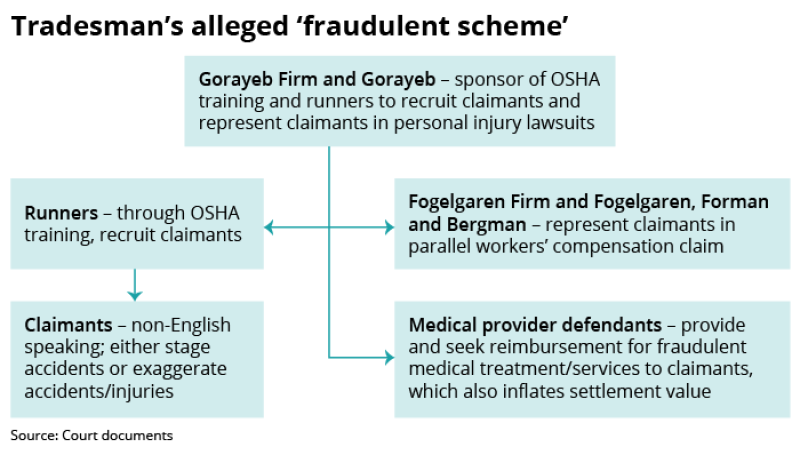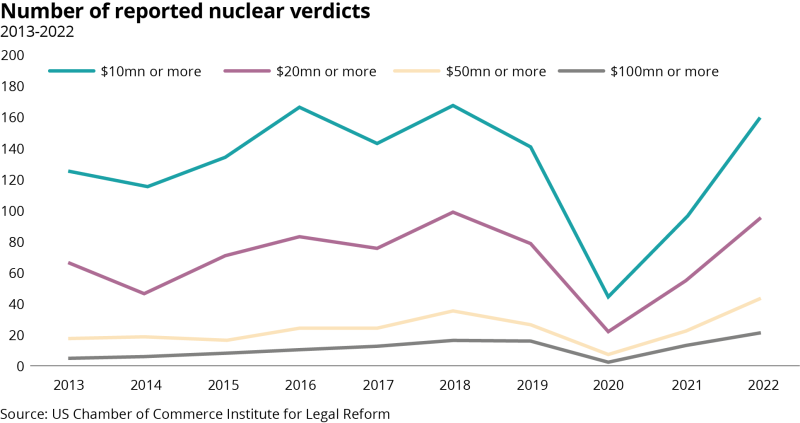
Tradesman is waging a legal battle against what could be the largest insurance fraud ring in the country, beyond anything seen in the commercial insurance space.
The MGA and parent company Roosevelt Road Re are claiming to have sustained financial damage from what they call an “enterprise” of medical and legal professionals which trained immigrant construction workers to inflate claims at NY construction sites.
Before the Rico complaints reach a verdict in court, these are allegations. But over its three-plus years of investigation, Tradesman has compiled evidence that seems compelling.
This includes videos of slip and falls that seem too minor to cause “permanent disabilities” to claimants, repeated misspelling of words like “functio” and “sofi-tissue” in medical notes and paper flyers that indicate ties between one of the law firms and OSHA training centers.
When I started asking around about the story last month, one question I asked sources was if the possibility of a large-scale insurance ring in NY construction was surprising for them. The short answer was no.
What many sources did find appalling, however, was the degree of organization behind these alleged criminal acts and how “blatant” they were – now that the evidence has been laid out, it seems surprising that nobody dug in deep before Tradesman.

A business decision
As far as the timeline goes, Tradesman claims the “fraudulent scheme" started prior to 2018. Sources agree that it could date back to much longer than that, possibly into the past decade or two.
The Covid-19 pandemic gave the firm conviction that something was wrong. Even as the construction industry slowed, claims counts didn’t fall.
New York construction has been a notorious line of business for P&C insurers, mainly for its state-specific labor laws that impose “absolute liability” to construction companies, property owners and contractors, regarding workers falls or injuries from fallen objects.
Swiss Re estimates that 90% of Labor Law 240 cases are ruled in favor of plaintiffs.
“There are firms on the plaintiff's side dedicated [to] doing nothing but labor law cases, because it's so damn easy to make money,” one defense attorney said.
Sources say that carriers have gotten used to the fact that a lot of these claims are difficult to combat, no matter how weak or nonsensical they are.
On top of that, investigating a claim or taking a case to court is an expensive endeavor – and probably an inefficient one for this particular line of business, where the legal playing field is skewed against the defendants.
Tradesman estimates it invested $5mn in the Rico complaints.
More broadly, sources point to the internal tendency of (re)insurers to treat claims as an expense factor rather than an investment, to explain the shortage of resources devoted to cracking down on fraud.
One attorney’s observation was that the industry did not miss out on what was going on, but made a business decision to “pay claims, raise premiums and still make the percentage of increase in profits”, instead of funding millions of dollars in lawsuits.
(Re)insurers have special investigation units (SIU) that work on fraudulent claims. But overall, in-house casualty claims personnel are overworked and under-compensated.
In the early 2000s, one source said, a caseload of 40 files was considered a big stack of excess casualty cases, whereas nowadays it’s not unusual to find adjusters working on more than 150.
This is because nuclear verdicts have increased and are triggering excess layers now more than ever. That overload continues as excess casualty limits are getting further compressed.

But compared to the ballooning workload, the budget allocated to casualty claims has not expanded to the same degree; in fact, the contrary is true, sources say.
That effect has manifested itself in multiple ways, not only among in-house claims specialists but in defense councils as well.
Adoption of technology in the claims space has brought in electronic billing systems at defense law firms, which some legal sources say is geared towards cutting expenses for carriers and does not reflect qualitative aspects such as an attorney’s skillset to actually litigate a claim.
“We’re not incentivizing them to win. We’re just paying them hourly rates,” said one casualty underwriting executive.
The cost of fraud
Insurance fraud has been around for as long as the industry. In contrast, social inflation has taken center stage as the recent buzz word; the ultimate culprit of loss drivers in US casualty.
The term encompasses a list of socio-economic factors: anti-corporate sentiment, a desensitization regarding large cash payouts, rampant advertising from plaintiffs’ attorneys as well as the use of litigation financing.
On that list, there isn’t a single item the P&C industry can control. That also applies to broad tort reform, which many sources say could curb the loss trend in casualty. However, no one knows when that might happen.
Tradesman’s complaints mainly pertain to NY construction, where the state-specific labor laws played a major role in creating the environment for suspicious claims to thrive.
Nonetheless, the case warrants reflection on the industry's narrative around the dominant role social inflation plays in loss costs, and whether it is making sure that no stones are left unturned in claims handling.
That is not to say that social inflation is not true. But pointing at social inflation while not investing in the tools to eradicate fake claims weakens the argument.
That reflection could start with (re)insurers asking themselves questions such as: are we allocating the right amount of claims per handler?; do we have in-house claims handlers who are lawyers that know how to take cases to court?; are we hiring top notch defense council?
By nature, defense attorneys and carriers are not collaborative amongst themselves; they are competitors and (re)insurers grapple with the fear of antitrust accusations.
The plaintiffs’ bar, on the other hand, are two decades ahead in sharing courtroom strategies and payout data to inflate settlements.
One silver lining coming out of the Tradesman-Rico case is that it provides earmarks for NY defense attorneys and carriers to spot similarities in open and closed claims.
For the first time, defense attorneys in NY are communicating on what they're seeing from clients as well as interactions with the plaintiff bar that could potentially substantiate the MGA's findings and uncover more.
Finding what went wrong is much easier when you know what you're looking for. And as the saying goes, better late than never.
